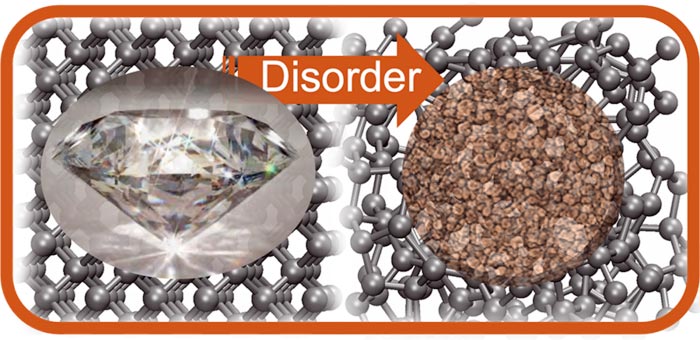A new look at disordered carbon

Unlike diamonds (left) and graphite, amorphous carbon (right) has no crystalline structure; PME researchers have now shed new light on its electronic properties.
Image courtesy of Galli Group
When carbon atoms stack into a perfectly repeating three-dimensional crystal, they can form precious diamonds. Arranged another way, in repetitive flat sheets, carbon makes the shiny gray graphite found in pencils. But there are other forms of carbon that are less well understood. Amorphous carbon—usually a sooty black material—has no repetitive molecular structure, making it challenging to study.
Now, researchers at the University of Chicago’s Pritzker School of Molecular Engineering (PME) have utilized a new framework for understanding the electronic properties of amorphous carbon. Their findings let scientists better predict how the material conducts electricity and absorbs light, and were published in Proceedings of the National Academy of Sciences (PNAS).
“We need to understand how disordered carbon works at a molecular level to be able to engineer this material for applications like solar energy conversion,” said Giulia Galli, the Liew Family Professor of Molecular Engineering and Professor of Chemistry at the University of Chicago. Galli also holds a senior scientist appointment at Argonne National Laboratory, where she is the director of the MICCoM center.
For decades, scientists have modelled the way the atoms move in amorphous carbon using the laws of classical mechanics—the set of equations that describe, for example, how a car accelerates or how a ball falls through the air. For some heavy atoms of the periodic table, these classical equations are a good approximation to accurately capture many of the materials’ properties. But for many forms of carbon, and amorphous carbons in particular, the team led by Galli has found that using these classical equations to describe the movement of atoms falls short.
“Amorphous carbon has many properties that make it valuable for a number of applications, however modeling and simulating its properties at the fundamental level is challenging,” said postdoctoral research scholar Arpan Kundu, PhD, the first author of the paper.
Galli has spent the last thirty years developing and applying quantum mechanical methods to model and simulate the properties of molecules and solids. She originally investigated amorphous carbon at the very beginning of her career, and she has recently returned to the challenge with new insight.
Galli, Kundu and undergraduate physics researcher Yunxiang (Tony) Song carried out new simulations of the electronic properties of amorphous carbon, this time integrating quantum principles to describe the movements of both the electrons and nuclei of carbon atoms. They found that using quantum mechanics for both—rather than classical mechanics for the nuclei—is critical to accurately predict the properties of amorphous carbon.
For instance, using their refined, quantum mechanical models, the PME team predicted a higher electrical conductivity than would have been otherwise expected.
The findings reported in the PNAS article are useful not only for understanding amorphous carbon, but other similar amorphous solids as well, the researchers said. But they also pointed out that much more work remains to be done—disordered carbon materials can exhibit radically different properties depending on their density, which in turn depends on the method used to prepare the material.
“When something is arranged in a crystal, you know exactly what its structure is, but once it is disordered, it can be disordered in many possible ways,” said Kundu.
The team plans to continue studying amorphous carbon and its potential applications.
Citation: “Influence of nuclear quantum effects on the electronic properties of amorphous carbon,” Kundu et al, Proceedings of the National Academy of Sciences, July 15, 2022. DOI: 10.1073/pnas.2203083119
Funding: U.S. Department of Energy through Argonne National Laboratory
Journal: Proceedings of the National Academy of Sciences
DOI: 10.1073/pnas.2203083119
Article Title: Influence of nuclear quantum effects on the electronic properties of amorphous carbon
Article Publication Date: 15-Jul-2022
Media Contact
Kelsey Ryan
University of Chicago
kmryan@uchicago.edu
Office: 7738342367
Cell: 8478045028
Original Source
All latest news from the category: Materials Sciences
Materials management deals with the research, development, manufacturing and processing of raw and industrial materials. Key aspects here are biological and medical issues, which play an increasingly important role in this field.
innovations-report offers in-depth articles related to the development and application of materials and the structure and properties of new materials.
Newest articles

Innovative 3D printed scaffolds offer new hope for bone healing
Researchers at the Institute for Bioengineering of Catalonia have developed novel 3D printed PLA-CaP scaffolds that promote blood vessel formation, ensuring better healing and regeneration of bone tissue. Bone is…

The surprising role of gut infection in Alzheimer’s disease
ASU- and Banner Alzheimer’s Institute-led study implicates link between a common virus and the disease, which travels from the gut to the brain and may be a target for antiviral…

Molecular gardening: New enzymes discovered for protein modification pruning
How deubiquitinases USP53 and USP54 cleave long polyubiquitin chains and how the former is linked to liver disease in children. Deubiquitinases (DUBs) are enzymes used by cells to trim protein…



